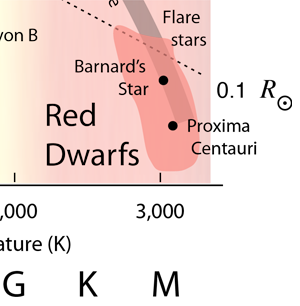Red Dwarf Stars
| At the small, cool, and low luminosity extreme on the Hertzsprung-Russell Diagram are dim stars which are called red dwarfs or M-dwarfs. These low-luminosity stars are difficult to observe from the Earth. Their radiation is largely in the invisible, infrared portion of the electromagnetic spectrum. Since the 1970s, it has been realized that they are the most common type of star in the solar neighborhood. They probably account for 80 percent or more of the total number of stars in the universe. One of the reasons that there are so many of them is that they burn so slowly that virtually all of them that have been created are still burning, whereas very massive stars have comparatively very short lifetimes. |  |
Star concepts
Reference:
Chaisson & McMillan, Sec 17.7
| HyperPhysics***** Astrophysics | R Nave |